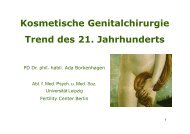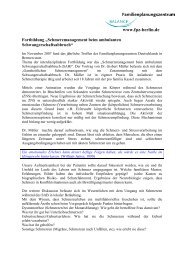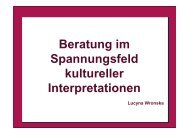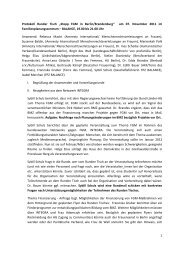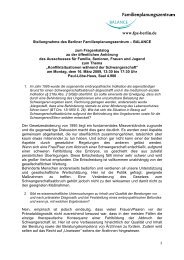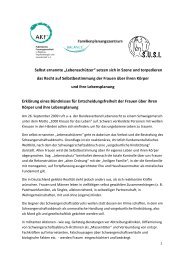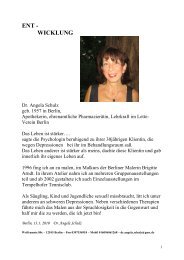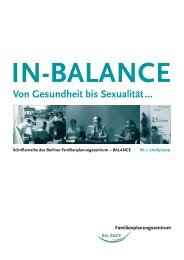Listening to African Voices - FPZ
Listening to African Voices - FPZ
Listening to African Voices - FPZ
Create successful ePaper yourself
Turn your PDF publications into a flip-book with our unique Google optimized e-Paper software.
It was not an easy task <strong>to</strong> get the Ethiopian immigrants <strong>to</strong>open up about the issue, and there is no doubt that it wouldhave been impossible <strong>to</strong> interview so many participantswithout two researchers of Ethiopian origin in the team.Many of the participants knew of an incident in southernGermany where an Ethiopian woman was accused of wanting<strong>to</strong> subject her daughter <strong>to</strong> FGM/C; they shared the way theywere exposed <strong>to</strong> stigmatising questions after the incident.“We hear that there are some <strong>African</strong>s who go back <strong>to</strong>their country taking their children and circumcise themand come back. We know that an Ethiopian woman inSouthern Germany was charged with having done this.But she didn’t do it and had no intention takeoff takingher daughter <strong>to</strong> be circumcised. At the time that newswas aired, a lot of Germans asked us whether we did thesame.” (members of group of women of Ethiopian origin)5.5.9.2. Proportion of immigrant population concernedAccording <strong>to</strong> the DHS conducted in 2005, three out of fourwomen in Ethiopia have undergone FGM/C. The prevalencerate is particularly high (> 85%) in the regions of Affar,Oromiya, Somali, Harari and Dire Dawa. The practice isreported <strong>to</strong> be considerably lower (< 30%) in the regions ofTigray and Gambela. The prevalence rates are about 66%in the region of the capital Addis Ababa and 69% in theAmhara region.More than half of the interviewed participants (55%)claimed <strong>to</strong> be Amhara, 17% are Oromo and 15% are affiliatedwith the group of the Tigre. The remaining 13% belong<strong>to</strong> different smaller ethnic groups.Table 33: Socio-demographic characteristics of immigrants from EthiopiaSocio-demographicvariableswomen(n = 36)men(n = 42)<strong>to</strong>tal sample(n = 78)Age (in years)Mean (standard deviation) 36.6 (9.3) 37.8 (11.2) 37.2 (10.3)Range 24-73 15-82 15-82Average education level (in years)Mean (standard deviation) 12.3 (3.3) 15.6 (3.9) 14.1 (4.0)Range 0-22 8-25 0-25ReligionMuslim 1 (2.8%) 2 (4.8%) 3 (3.8%)Christian 34 (94.4%) 39 (92.9%) 73 (93.6%)Traditional religion 0 (0.0%) 1 (2.4%) 1 (1.3%)None believers 1 (2.8%) 0 (0.0%) 1 (1.3%)Social statusMarried (monogamous) 20 (55.6%) 18 (42.9%) 38 (48.7%)Married (polygamous) 1 (2.8%) 2 (4.8%) 3 (3.8%)Separated/divorced/widowed 8 (22.2%) 4 (9.5%) 12 (15.4%)Never been married 22 7 (19.4%) 18 (42.9%) 25 (32.1%)Migrated from a(n)Urban area 33 (94.3%) 33 (84.6%) 66 (89.2%)Rural area 2 (5.7%) 6 (15.4%) 8 (10.8%)Residence statusUnbefristet (indefinite residence permission) 22 (61.1%) 16 (38.1%) 38 (48.7%)Befristet (temporary residence permission) 9 (25.0%) 15 (35.7%) 24 (30.8%)Duldung (<strong>to</strong>leration) 0 (0.0%) 0 (0.0%) 0 (0.0%)Others/no papers/does not answer 0 (0.0%) 1 (2.4%) 1 (1.3%)German nationality 5 (13.9%) 10 (23.8%) 15 (19.2%)Time spent in Germany (in months)Mean (standard deviation) 97.4 (59.3) 123.3 (95.8) 111.3 (81.6)Range 2-288 2-360 2-36066<strong>Listening</strong> <strong>to</strong> <strong>African</strong> <strong>Voices</strong>





